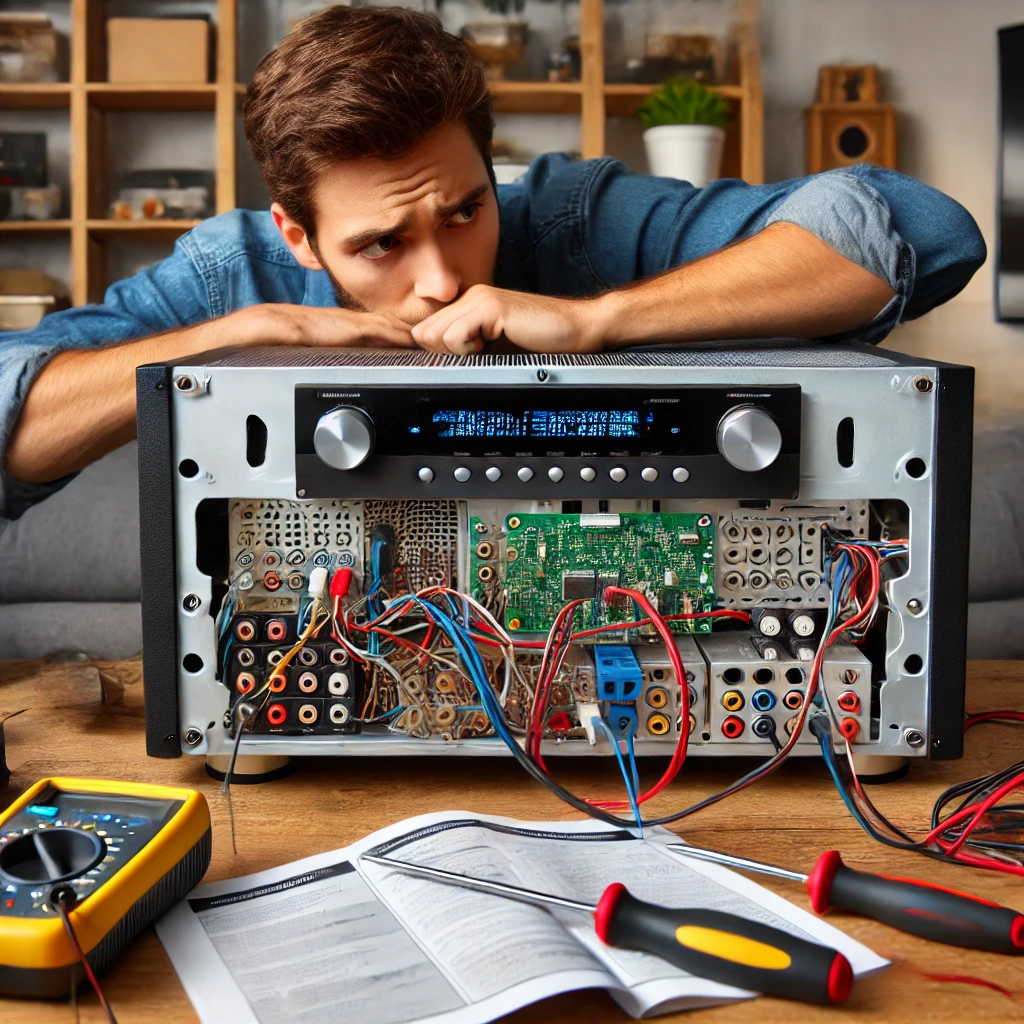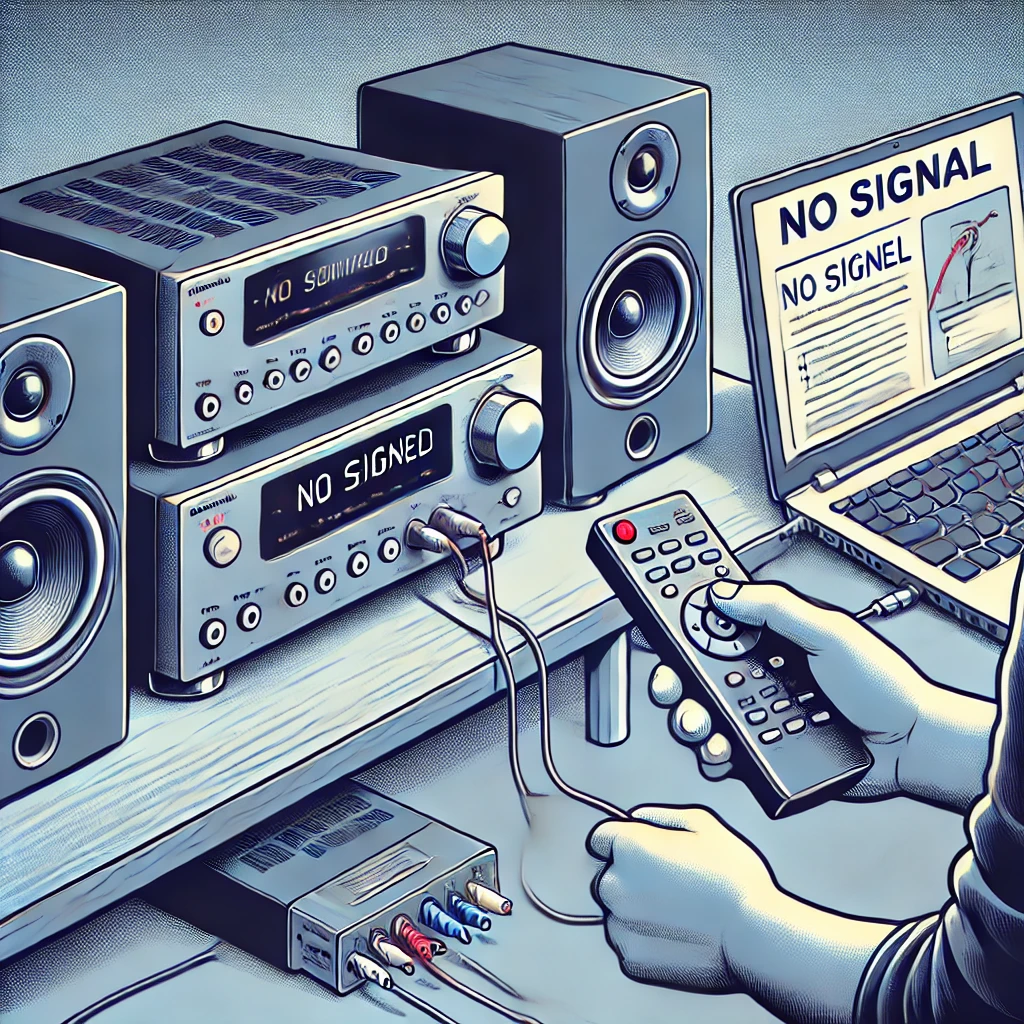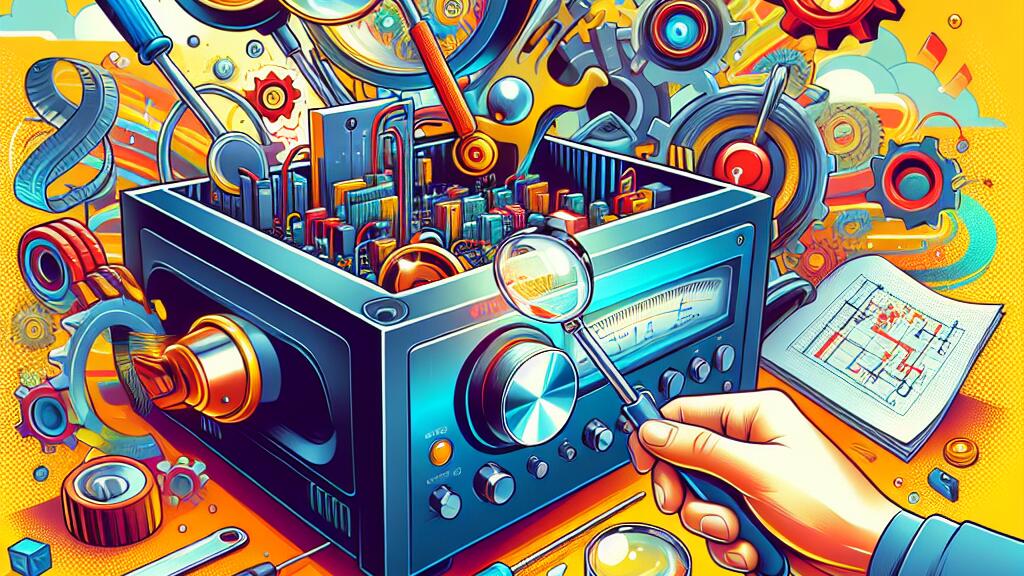Table Of Contents
Troubleshooting Common Issues with Stereo Receivers for Optimal Performance
Key Takeaways
- Resolving frequent challenges related to audio systems while comprehending their functions.
- Typical problems encountered with audio systems.
- Fixing the absence of audio output.
- Enhancing subpar audio performance.
- Dealing with remote control operational issues.
- Tackling overheating concerns.
- Addressing signal disruption challenges.
Troubleshooting Common Issues With Stereo Receivers | Understanding Stereo Receivers
Understanding stereo receivers is crucial for effective troubleshooting common issues with stereo systems. These devices serve as the central hub for managing audio signals, providing an interface between various audio sources, such as CD players, streaming devices, and soundbars. A competent troubleshooter must be familiar with how receivers operate to effectively troubleshoot issues like sound quality or connectivity problems. Many users often rely on av receivers to enhance their home audio experience, but without a proper understanding of their components and functionality, troubleshooting can become challenging. Recognizing the common features and potential pitfalls of stereo systems allows users to address concerns efficiently and maintain optimal performance.
Troubleshooting Common Issues with Stereo Receivers | What is a Stereo Receiver?
A stereo receiver acts as the central hub for audio systems, combining various functions to enhance sound output. It receives audio signals from different sources, including FM tuners, and amplifies them for distribution to speakers. This device is essential for ensuring high-quality music playback and managing sound systems efficiently. Understanding its role is crucial in troubleshooting common issues with stereo receivers.
The performance of a receiver can be affected by numerous factors, including distortions and interference that may arise from external sources. Troubleshooting common issues with stereo receivers often involves checking connections and settings to minimize these problems. A well-functioning receiver not only improves audio quality but also enhances the overall experience of the sound system.
Key Components of Stereo Receivers
A stereo receiver serves as the heart of an audio-visual setup, integrating various audio equipment to deliver optimal sound quality. Key components include transistor amplifiers and differential amplifiers, which work to enhance audio signals and reduce distortion. Tuners allow users to access radio frequencies, while optical audio inputs support high-quality digital sound. Understanding these elements is crucial for troubleshooting common issues with stereo receivers, ensuring that listeners enjoy the full potential of surround sound.
The design of the AV receiver plays a significant role in sound distribution and control. It manages multiple audio sources and allows for seamless switching between them. This functionality is essential for those who use their equipment for a variety of media, from streaming music to watching movies. By familiarizing yourself with these components, you can more effectively address challenges that may arise, including interference or sound quality concerns.
| Component | Description | Functionality |
|---|---|---|
| Transistor Amplifiers | Devices that amplify audio signals | Enhance sound quality and reduce distortion |
| Differential Amplifiers | A type of amplifier that compares two input signals | Improves audio clarity and minimizes noise |
| Tuners | Modules that enable access to radio frequencies | Allows users to listen to AM/FM radio stations |
| Optical Audio Inputs | Digital inputs using fiber optics | Supports high-quality sound transmission |
| Multi-source Management | Feature that controls multiple audio inputs | Facilitates easy switching between audio sources |
Common Issues with Stereo Receivers
Stereo receivers are crucial components in audio systems, serving as the hub for sound quality enhancement and signal processing. Troubleshooting common issues with stereo receivers often involves examining the tuner and addressing potential malfunctions within the amplifier stages. Poor sound quality can arise from various factors, including improper tuning or interference from RF signals, which may require adjustments utilizing a bandpass filter to isolate and enhance the desired audio frequencies. An efficient transmitter setup can significantly impact the overall sound effect by ensuring clear signal reception. Regular checks and maintenance can prevent these issues, leading to a more enjoyable audio experience.

No Sound Output
Experiencing sound issues with your stereo receiver can be frustrating. Troubleshooting Common Issues with Stereo Receivers begins with ensuring that all connections are secure. Loose or improperly connected cables can significantly affect audio performance. It’s essential to check the input impedance and make sure it matches the specifications of your speakers. A small signal might fail to trigger the transistors effectively, resulting in no output.
The absence of sound can also stem from problems with audio/video sync or issues with Dolby audio settings. Sometimes, video signals may interfere with audio playback, causing noise or distortion. Ensuring that the receiver is configured correctly for your audiovisual setup can resolve these problems. Taking the time to methodically assess each component can lead to a successful resolution.
Poor Sound Quality
Poor sound quality can often be traced to several factors related to the signal transmission and processing within the stereo receiver. The performance of the amplifier can significantly impact the audio output. Transistor malfunctions or issues in the stereo demultiplexer can result in distorted sound. Troubleshooting common issues with stereo receivers requires checking the settings and configurations that affect audio clarity, especially when using diverse video formats or two-way radios.
Another crucial aspect of sound quality is the interaction with other electronic devices. Signal interference from nearby electronics can degrade audio performance. Implementing radio troubleshooting methods can help identify whether external factors affect the receiver’s output. Addressing these elements while focusing on both hardware and software solutions is essential for restoring the integrity of sound in any audio setup. Troubleshooting common issues with stereo receivers ensures that all components function harmoniously, providing an optimal listening experience.
Troubleshooting No Sound Output
Addressing audio system issues can often begin with understanding the nuances of the stereo unit. Troubleshooting Common Issues with Stereo Receivers frequently involves examining connections and settings to identify the source of noise problems. A thorough check of all cables ensures that receivers are properly linked. Inspecting audio settings is essential; sometimes, adjustments can reveal that the output is muted or incorrectly configured. For those using surround sound systems, ensuring that each speaker is correctly connected can drastically affect sound output. A proper evaluation may lead to identifying low distortion and enhancing overall audio performance, thereby resolving common audio system issues.
Checking Connections
Proper connections play a crucial role in troubleshooting common issues with stereo receivers. Loose or incorrectly connected cables can lead to poor audio or no sound at all. Many receivers require specific configurations for external sound systems. Checking the audio sync option is vital, as an improperly set sync can result in sound quality issues. A thorough troubleshooting procedure should begin by verifying all connections, ensuring that each cable is securely plugged in and correctly routed.
If audio persists despite correct connections, it may indicate deeper issues. Audio signal generators can help test the integrity of the incoming audio, ensuring that the receiver is receiving signals properly. Identifying whether the problem lies in the receiver or the external sound systems will guide you in resolving the issue efficiently. A systematic approach will not only help in diagnosing the problem but also enhance overall sound quality when listening to your favorite music or shows.
- Check all cable connections for looseness or misalignment.
- Ensure that each cable is connected to the correct input/output ports.
- Verify the audio sync settings on the receiver and adjust as necessary.
- Test the audio signal generator to confirm incoming audio integrity.
- Inspect external sound systems for any faults or disconnections.
- Consider testing the receiver with a different audio source to isolate the problem.
- Consult the receiver’s manual for any specific setup requirements or troubleshooting tips.
Inspecting Speaker Wires
A critical step in troubleshooting common issues with stereo receivers involves inspecting the speaker wires. Disconnect speakers and carefully examine the wires for any visible damage such as fraying or cuts. This damage can result in a mute output or poor quality sound. For general troubleshooting purposes, replacing any faulty wires can resolve common audio issues that arise from wrong equipment use.
Testing different audio sources may also require attention to the speaker wires. Ensure that all connections are secure and that the wires are properly connected to both the receiver and speakers. A master troubleshooter approach can help identify if the problem lies in the wiring or if the issue is more complex. Utilizing shotgun troubleshooting techniques will help isolate the source of the problem effectively.
Resolving Poor Sound Quality
Poor sound quality can stem from various factors, making troubleshooting common issues with stereo receivers essential to achieving optimal audio performance. One common cause is improper volume settings that may lead to distorted audio or muffled bass. Examining the audio transmission pathways, including audio RCA inputs, can reveal hidden sync issues. Output transistors may also be at fault; a blown output transistor often results in significant sound degradation. For complex audio-video devices, adjusting audio delay settings can enhance the listening experience. Prioritizing these checks can mitigate many common audio problems, improving overall sound clarity.

Adjusting Equalizer Settings
Fine-tuning the equalizer settings is crucial for achieving the desired sound quality in home audio systems. Poor adjustments may lead to low noise or a noisy part in the playback. If the equalizer is not configured correctly, it can exacerbate issues like wrong speaker or wrong surround sound distributions. By addressing these settings, users can significantly enhance their audio experience and meet their audio demands more effectively.
Listening to various playback sources may highlight the need for adjustments in the equalizer. If one source sounds significantly better or worse than another, this may indicate an audio delay capability issue or improper speaker placement. It can be helpful to swap speakers or experiment with different playback sources to identify the settings that yield the best sound. Effective adjustment of equalizer settings plays a vital role in troubleshooting common issues with stereo receivers.
Testing with Different Sources
Different audio sources can sometimes reveal underlying issues with your stereo receiver. For effective troubleshooting common issues with stereo receivers, experiment with various audio inputs. If you notice high frequency noise or a lack of surround sound effect, the problematic speaker might be linked to a specific audio source. Switching between devices such as a CD player and external USB sound can help identify the root cause of the issue.
Testing various audio sources may also uncover sound direction problems that stem from the receiver itself or the emitter settings. By assessing how the audio work transpires with different inputs, you can pinpoint whether the problem lies within a specific audio source or if it is a broader issue with the stereo receiver. This methodical approach is crucial for troubleshooting common issues with stereo receivers.
Issues with Remote Control Functionality
Remote control problems can significantly impact your experience with stereo receivers, especially during playback of audio sounds. Troubleshooting Common Issues with Stereo Receivers often reveals that video issues or low volume can stem from a bad device or a defective device. Sometimes, the malfunction may be linked to a circuit design error affecting the remote’s functionality. Users may encounter difficulties when trying to switch between source audio or operate multi-speaker surround sound setups. Addressing these challenges promptly can enhance performance and restore seamless control over your audio environment.
Common Remote Control Problems
Remote control issues can greatly hinder the performance of your stereo receiver. A frequent problem involves the remote not responding, which may be due to signal devices being obstructed or out of range. Ensure that a clear line of sight is available between the remote and the receiver. Consider developing a troubleshooting plan that addresses potential signal limiting factors. Checking for low distortion sine waves in the remote’s output can also reveal if the issue stems from the remote itself, rather than the stereo system.
Another common concern arises when the stereo receiver switches to the wrong channel unexpectedly. This can disrupt audio quality and affect listening experiences. Signal bjts or poor performance tuners may cause this confusion, especially if the remote sends mixed signals. It’s crucial to familiarize yourself with the 4-bar color codes that indicate different functions. By doing so, you enhance your troubleshooting strategy for common issues with stereo receivers, ensuring that you enjoy seamless audio playback.
Replacing Batteries in the Remote
A frequent issue in troubleshooting common issues with stereo receivers relates to remote control functionality. Many users encounter problems with sound quality and volume control due to dead batteries in their remotes. Checking the battery compartment for corrosion or ensuring the batteries are correctly installed can resolve these issues. It’s important to consider that bad connections can also contribute to the remote’s inefficiency, affecting the amplifier output ports and the overall audio experience.
Before replacing the batteries, ensure that you’re using the correct audio source. If the problem persists, compatibility problems between the remote and the stereo receiver may be at play. Real knobs on the device can be utilized as a temporary measure to adjust settings, but ultimately replacing the batteries will ensure a smooth operation. Properly functioning remotes are essential for controlling coupled power amplifiers efficiently and maintaining optimal sound quality.
Addressing Overheating Problems
Overheating problems in stereo receivers can often stem from issues within the amplifier circuit. Effective troubleshooting common issues with stereo receivers starts with ensuring that the audio power amp is not overworked. A faulty loudness control can contribute to excessive heat, especially if the volume configuration is set too high. Sound quality may degrade with noise level changes that are indicative of overheating components. Implementing sync adjustments can help monitor performance, while a 4-band scheme may assist in distributing the audio load evenly. If defective parts are present, immediate attention will prevent further issues and ensure optimal functionality.
Ensuring Proper Ventilation
Proper ventilation is essential for maintaining the optimal performance of stereo receivers. Overheating can lead to component failures and hinder audio quality. Troubleshooting Common Issues with Stereo Receivers frequently involves checking for adequate airflow around the unit. Ensure that no audio cables obstruct ventilation openings. Paralleled transistors can generate significant heat, making it crucial to keep the receiver in a well-ventilated area to avoid control issues.
Effective cooling methods may include placing the receiver in an open space, away from heat sources. An FFT spectrum analyzer can help monitor temperature variations during operation. Loose connections, particularly with the antenna connector, may also exacerbate overheating by forcing components to work harder, leading to audio delay. Keeping emitter resistors in good condition will further support the longevity and reliability of the stereo receiver.
| Factors Affecting Ventilation | Potential Issues | Recommended Solutions |
|---|---|---|
| Obstructed Airflow | Overheating, Component Failure | Keep cables away from ventilation openings |
| Surrounding Environment | Limited Air Circulation | Place receiver in an open space, away from heat sources |
| Temperature Monitoring | Increased Operating Temperatures | Utilize FFT spectrum analyzer for temperature checks |
| Connection Quality | Audio Delay, Reduced Performance | Maintain secure connections, particularly with antenna |
Identifying Overworked Components
Overworked components in a stereo receiver can lead to a range of problems affecting audio qualities. Symptoms such as a beeping radio or diminished sound output signal potential issues with low impedance circuitry. Troubleshooting Common Issues with Stereo Receivers often involves checking for faulty connections or fuse issues that can cause components to overwork. A thorough examination of the radio antenna connection and ensuring the correct speaker configuration can also help alleviate stress on the receiver’s internal parts.
Screen resistors play a critical role in maintaining functional performance and preventing overheating. If these components are overburdened, it can lead to distortion or complete failure of sound output. Addressing these problems promptly is essential for troubleshooting common issues with stereo receivers, ensuring that the system operates within its intended parameters. Regular maintenance and awareness of potential overwork can significantly extend the life of your stereo receiver.
Troubleshooting Signal Interference
Signal interference can significantly impact the quality of home theatre audio systems. For effective troubleshooting, it is essential to identify the source of the problem, such as electrical interference from nearby devices or outdated circuit components. A thorough examination of affected speakers and connections can reveal issues like noisy pots or improperly adjusted equalizer controls, which may contribute to poor sound. The first transistor in the system may also need to be inspected to ensure it is functioning correctly. Adjusting antenna placement can improve reception, addressing the radio isn and enhancing overall sound quality. By carefully implementing these steps, one can effectively tackle signal interference in stereo receivers.
Checking for Electrical Interference
Electrical interference can significantly impact the performance of your stereo receiver. Problems may arise from nearby devices that share the same radio frequencies or operate on similar circuits. Common issues often include distorted sound or unexpected volume fluctuations, especially when tuning into specific channels. Identifying the source of interference can be crucial for restoring the quality of your music and ensuring optimal performance from your equipment.
To effectively troubleshoot this issue, consider the placement of your stereo receiver and any connected devices. Keep the receiver away from other electronic equipment, such as routers, microwaves, or power strips, as these can disrupt the signal. Checking connectors and ensuring that all wiring is intact can also help mitigate interference. By addressing these potential causes, you can enhance the listening experience and resolve issues related to electrical interference in your stereo setup.
- Regularly inspect and reposition wires and cables to avoid tangles and interference.
- Use high-quality cables that are shielded against electrical noise.
- Turn off nearby appliances temporarily to identify potential sources of interference.
- Keep the stereo receiver elevated and in a well-ventilated area to reduce heat and electromagnetic exposure.
- Consider using power conditioners to filter out unwanted electrical noise.
- Utilize ferrite beads on cables to suppress high-frequency interference.
- Check for firmware updates for your stereo receiver and connected devices, as these can improve performance.
Optimizing Antenna Placement
Proper antenna placement is crucial for enhancing the signal strength of your stereo receiver. Often overlooked, this step can significantly impact the device’s performance, particularly when troubleshooting common issues with stereo receivers. Adjustments might be necessary based on the band and channel you wish to optimize. Ensuring that the antenna is positioned away from other electronic components and maintaining the correct settings can help in achieving better reception and sound quality.
Testing different locations for your antenna can reveal the optimal positioning for your system. A few inches can make a difference when it comes to receiving signals effectively. Check connections regularly to ensure they are secure and clean, as poor connections can lead to signal loss. Exploring various heights and angles can help control signal interference and improve overall performance, aiding in the troubleshooting of common issues with stereo receivers.
Conclusion
Troubleshooting common issues with stereo receivers is essential for maintaining optimal audio performance. By understanding the components and functions of a stereo receiver, users can effectively address problems such as no sound output or poor sound quality. The importance of proper connections, speaker wire inspections, and equalizer adjustments cannot be overstated, as these factors significantly affect the surround sound experience. Taking the time to identify and resolve issues not only enhances listening enjoyment but also prolongs the life of the equipment. Adopting a systematic approach to troubleshooting common issues with stereo receivers leads to better sound quality and overall satisfaction with your home audio setup.
FAQS
What steps should I take for two-way radio troubleshooting when dealing with audio-related issues in my stereo receiver?
When troubleshooting two-way radio audio-related issues in your stereo receiver, first check mute options to ensure the audio is not silenced. Next, inspect the speaker wiring to ensure proper connections. If you experience audio delay capabilities, evaluate the settings and performance of the receiver. It may also help to test the wide bandwidth waveforms for clarity. Finally, consider using a 3-band scheme for adjusting the equalizer settings and perform in-circuit tests to diagnose any underlying issues.
How can I perform two-way radio troubleshooting when I experience sound problems with my stereo receiver, specifically regarding speaker connections?
To conduct effective two-way radio troubleshooting for sound issues in your stereo receiver, it’s essential to check speaker wiring thoroughly. Ensure all connections are secure, and there are no frayed wires that might be causing the problem.
What techniques can be applied for troubleshooting audio issues in my stereo receiver, particularly for distortion and clarity problems?
To troubleshoot audio issues in your stereo receiver, particularly regarding distortion and clarity, you should check all connections to ensure they’re secure, inspect speaker wires for damage, and tweak equalizer settings. Additionally, testing different sources or input options can help isolate the problem, and if necessary, replacing any faulty components will improve sound quality.
What common audio problems might arise in my stereo receiver that require troubleshooting?
Common audio problems in a stereo receiver may include issues such as distortion, lack of clarity, or sound degradation. Troubleshooting these issues often involves checking speaker connections, ensuring that the receiver settings are correctly configured, and examining input sources for any potential problems.
What are some effective methods for troubleshooting audio quality in my stereo receiver system?
To troubleshoot audio quality in your stereo receiver system, start by checking all connections to ensure they are secure and working. Next, inspect the speakers for any signs of damage, and consider adjusting the equalizer settings to optimize sound. If the issue persists, try different audio sources to determine if the problem lies with the receiver or an external device. Finally, refer to the user manual for specific troubleshooting techniques related to your model.

